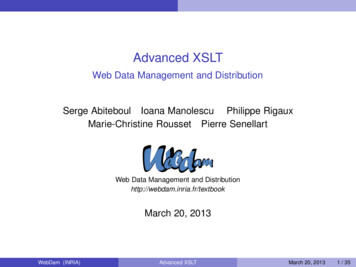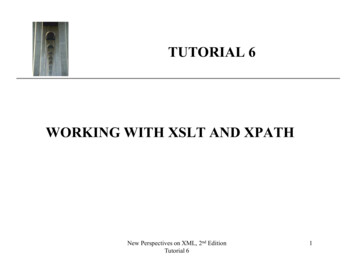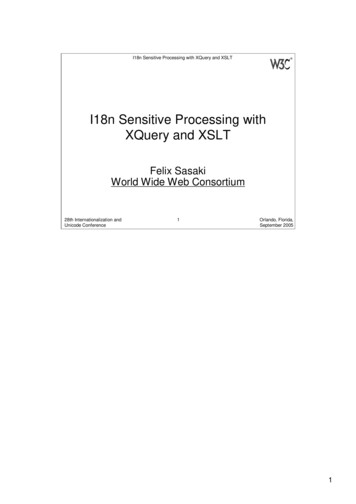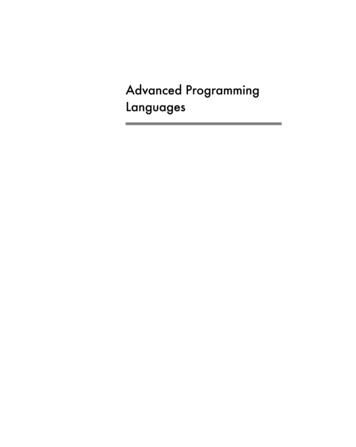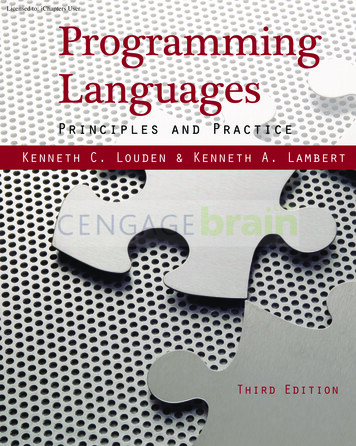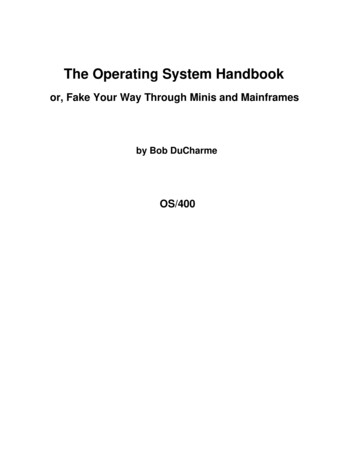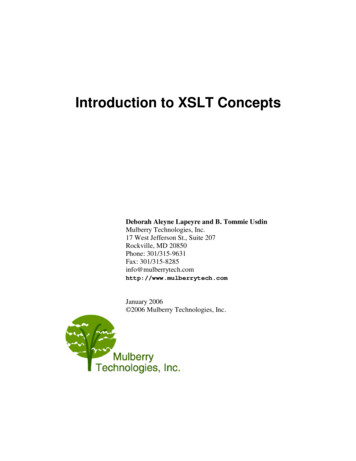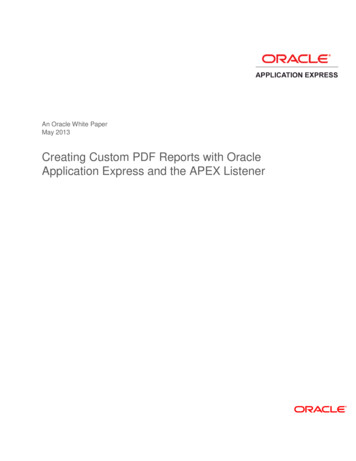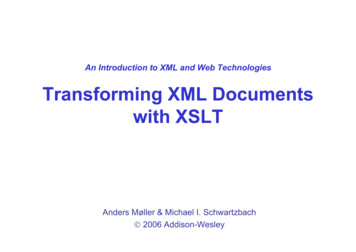
Transcription
xslt#xslt
Table of ContentsAbout1Chapter 1: Getting started with xslt2Remarks2Versions2Examples2Installation or Setup2Simple XSLT example3Chapter 2: Variables in xslt7ExamplesXslt VariablesCredits778
AboutYou can share this PDF with anyone you feel could benefit from it, downloaded the latest versionfrom: xsltIt is an unofficial and free xslt ebook created for educational purposes. All the content is extractedfrom Stack Overflow Documentation, which is written by many hardworking individuals at StackOverflow. It is neither affiliated with Stack Overflow nor official xslt.The content is released under Creative Commons BY-SA, and the list of contributors to eachchapter are provided in the credits section at the end of this book. Images may be copyright oftheir respective owners unless otherwise specified. All trademarks and registered trademarks arethe property of their respective company owners.Use the content presented in this book at your own risk; it is not guaranteed to be correct noraccurate, please send your feedback and corrections to info@zzzprojects.comhttps://riptutorial.com/1
Chapter 1: Getting started with xsltRemarksXSLT (XSL Transformations, Extensible Stylesheet Language Transformations) is a programminglanguage that is based on XML and whose purpose is to manipulate and transform XML. It is afunctional programming language and a W3C standard. Using XSLT you can transform one ormore XML documents into a result that could have variety of output formats (XML, HTML, text).To understand XSLT -- it is best to have a good working knowledge of:1. XML2. XPathWithout these two underlying concepts you would have difficulty learning XSLT. Firstly, becausean XSLT document is an XML document. And secondly, XSLT documents make use of XPath toquery the XML document being transformed.Recommended reading: pecificationStatusRelease DateXSLT -18XSLT 01-23XSLT 3.0https://www.w3.org/TR/xslt-30Candidate Recommendation2015-11-19ExamplesInstallation or SetupXSLT is a special-purpose programming language; it is widely used for transforming XMLdocuments either into a different XML format, into HTML, or into text-based formats.There are two main versions of XSLT in use: XSLT 1.0 and XSLT 2.0. XSLT 1.0 is more widelyimplemented but has many restrictions and limitations compared with XSLT 2.0; you will need todecide which version to use. If an XSLT 2.0 processor is available for your chosen environment,then this is almost always the better choice.(XSLT 1.0 came out in November 1999, and many implementations appeared within a year or two,both from mainstream vendors such as Microsoft, IBM, Sun, and Oracle, and from individualenthusiasts working in their spare time. XSLT 2.0 came out in January 2007, and many of thehttps://riptutorial.com/2
original 1.0 processors were never upgraded, because their developers had lost interest. The mostwidely used XSLT 2.0 processor is Saxon, but it does not have the field to itself: other freestanding products include RaptorXML (from Altova), XmlPrime (from CBCL) and Exselt, and 2.0processors are also available embedded in IBM's WebLogic, in MarkLogic's XML database server,and in Intel's XML Accelerator.)The specification of XSLT 3.0 is technically complete (Proposed Recommendation in April 2017)but is best regarded as bleeding-edge for the time being: only consider it if you have a pressingneed for its new features, such as streaming, packages, JSON support, or try/catch. There arethree known implementations: Saxon, Exselt, and RaptorXML.To get started with XSLT you have several options: Use an online XSLT tool. There are several available (search for "online XSLT tool"), a veryreliable online IDE is http://xsltransform.net/. This is a good way of getting an initial feel forthe language, but you won't want to carry on this way once you are doing real development. Use the XSLT engine built into every browser. As with online tools, these have theadvantage that you don't need to install anything; but the browsers only support XSLT 1.0,they only support XML-to-HTML conversion, and they have very weak debugging support. Avery recent -- but still experimental -- development is Saxon-JS, which allows execution ofXSLT 2.0 (and parts of XSLT 3.0) in the browser. Install an XSLT processor (such as Saxon or xsltproc). Most of these products can beinvoked using the operating system command line, or using an API for particularprogramming languages such as Java, C, C#, or Python. Install an XML development environment such as Altova XML Spy, oXygen from SyncroSoft,or Stylus Studio. Although this is a more expensive option, it gives much richer developmentsupport and debugging capability.Whichever option you choose, you should first decide whether you want to use XSLT 1.0 or XSLT2.0.Simple XSLT exampleHere's a simple example that uses XSLT to convert data in an XML file into a table in an HTMLfile. You can use it to experiment with simple XSLT transforms.Prerequisite: Install a Java Runtime Environment and add the location of the JRE to your PATHvariable. (On Windows, most installers will add Java to your path for you.) If this works, you shouldbe able to open a command-line window and run the command java -version and get a printout ofinfo about your JRE.1. Download the Saxon-HE XSLT processor for Java here: saxon.sourceforge.net and unzip itto anywhere on your computer.2. In a text editor, create a file named pets.xml with the following code: pets https://riptutorial.com/3
petType name "Dogs" pet id "123" name "Sparky" vaccineStatus "vaccinated" healthStatus "healthy"/ pet id "234" name "Sadie" vaccineStatus "unvaccinated" healthStatus "sick"/ pet id "345" name "Herman" vaccineStatus "unvaccinated" healthStatus "unknown"/ /petType petType name "Cats" pet id "456" name "Cleo" vaccineStatus "vaccinated" healthStatus "healthy"/ pet id "567" name "Janet" vaccineStatus "unvaccinated" healthStatus "healthy"/ pet id "678" name "Furry" vaccineStatus "vaccinated" healthStatus "sick"/ /petType /pets 3. In a text editor, create a file named petTransform.xsl with the following code: xsl:stylesheet xmlns:xsl "http://www.w3.org/1999/XSL/Transform"version "2.0" !-- handle the root XML element -- xsl:template match "/" html head title Pets that are available for adoption /title /head body xsl:apply-templates/ /body /html /xsl:template xsl:template match "pets" xsl:apply-templates/ /xsl:template xsl:template match "petType" h2 xsl:value-of select "@name"/ /h2 table id "{@name}" tr th colname "id" ID /th th colname "name" Name /th th colname "vaccinated" Vaccine status /th th colname "health" Health status /th /tr tbody !-- add a row for each pet in this category -- xsl:for-each select "pet" tr td colname "id" xsl:value-of select "@id"/ /td td colname "name" xsl:value-of select "@name"/ /td td colname "vaccinated" xsl:value-of select "@vaccineStatus"/ /td td colname "health" xsl:value-of select "@healthStatus"/ /td /tr /xsl:for-each /tbody /table /xsl:template !-- ignore the content of other tags because we processed them elsewhere -- xsl:template match "*" !-- do nothing -- /xsl:template https://riptutorial.com/4
/xsl:stylesheet 4. Open a command-line window and go to the folder with the XML and XSLT files.5. Run the following command, where path to saxon.jar is the full path to the file saxon9he.jar:java -jar "path to saxon.jar" -opetOutput.html -s:pets.xml -xsl:pettransform.xsltFor example:java -jar "C:\Program Files\SaxonHE9-7-0-7J\saxon9he.jar" -opetOutput.html -s:pets.xml -xsl:pettransform.xsltMake sure to run this command on a single line.6. Open the output file petOutput.html in a text editor. It should look like this: html head meta http-equiv "Content-Type" content "text/html; charset UTF-8" title Pets that are available for adoption /title /head body h2 Dogs /h2 table id "Dogs" tr th colname "id" ID /th th colname "name" Name /th th colname "vaccinated" Vaccine status /th th colname "health" Health status /th /tr tbody tr td colname "id" 123 /td td colname "name" Sparky /td td colname "vaccinated" vaccinated /td td colname "health" healthy /td /tr tr td colname "id" 234 /td td colname "name" Sadie /td td colname "vaccinated" unvaccinated /td td colname "health" sick /td /tr tr td colname "id" 345 /td td colname "name" Herman /td td colname "vaccinated" unvaccinated /td td colname "health" unknown /td /tr /tbody /table h2 Cats /h2 table id "Cats" tr https://riptutorial.com/5
th colname "id" ID /th th colname "name" Name /th th colname "vaccinated" Vaccine status /th th colname "health" Health status /th /tr tbody tr td colname "id" 456 /td td colname "name" Cleo /td td colname "vaccinated" vaccinated /td td colname "health" healthy /td /tr tr td colname "id" 567 /td td colname "name" Janet /td td colname "vaccinated" unvaccinated /td td colname "health" healthy /td /tr tr td colname "id" 678 /td td colname "name" Furry /td td colname "vaccinated" vaccinated /td td colname "health" sick /td /tr /tbody /table /body /html 7. Open the output file petOutput.html in a web browser. It should show the data in a simpletable.Read Getting started with xslt online: arted-with-xslthttps://riptutorial.com/6
Chapter 2: Variables in xsltExamplesXslt VariablesGlobal Variable: This variable is available everywhere in the xsl stylesheet. This variable shouldonly be the child of xsl:stylesheet element.Local variable: This variable is only available where it is declared.See Below Code: ?xml version "1.0" encoding "UTF-8"? xsl:stylesheet xmlns:xsl "http://www.w3.org/1999/XSL/Transform"xmlns:xs refixes "xs"version "2.0" xsl:output omit-xml-declaration "yes"/ xsl:variable name "a" select "5"/ !-- Global Variable -- xsl:template match "/" xsl:variable name "b" select "2"/ !--Local Variable -- xsl:value-of select " a b"/ !--Addition of 'a' and 'b' -- /xsl:template /xsl:stylesheet The Output of the above code would be: 7There are two ways to define a value to the variable like:By xpath expression in the @select attribute of xsl:variable element like: xsl:variable name "apple" select "'RED'"/ ORBy the content of the xsl:variable element like: xsl:variable name "apple" RED /xsl:variable To call a declared variable use Sign with variable name, like in above code ' a'Read Variables in xslt online: -in-xslthttps://riptutorial.com/7
CreditsS.NoChaptersContributors1Getting started withxsltCommunity, Daniel Haley, Dimitre Novatchev, Eero Helenius,JLRishe, Lukasz, Mads Hansen, Mathias Müller, Michael Kay,Nate, Tim McMackin2Variables in xsltpallo, Tim Chttps://riptutorial.com/8
There are two main versions of XSLT in use: XSLT 1.0 and XSLT 2.0. XSLT 1.0 is more widely implemented but has many restrictions and limitations compared with XSLT 2.0; you will need to decide which version to use. If an XSLT 2.0 processor is available for your chosen environment, then this is almost always the better choice.
